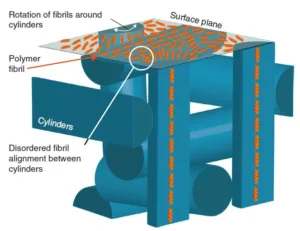Polymers that emit circularly polarized light have the potential to enable more efficient OLED displays. However, at this time, the origin of circular polarized light emission in such materials is not well understood. Now, research by a team headed by Jessica Wade of the Department of Physics, Imperial College London, South Kensington Campus (London, UK) reports achieving important insight.

The resulting new molecular model may suggests means that allow preparation of polymers that can strongly emit circularly polarized light.
To understand what follows, several definitions are useful. The first is that the term chiral means asymmetric in such a way that an object and its mirror image are not superimposable. Right and left handed circularly polarized light have this property. The second is that unpolarized light can be thought of as being composed equally of right handed and left handed circularly polarized light.
Now, a little background information on why the development of materials that emit circularly polarized light would be significant.
Conventional OLEDs emit unpolarized light. In addition, it is common for the upper surface of OLED displays to include a circular polarizer as an antiglare filter that serves to suppress reflection of ambient light. Unfortunately, a circular polarizing antiglare filter blocks one polarization of the unpolarized light emitted by the OLED. As a result, the inclusion of an antiglare filter reduces the brightness of the emitted light by about half. The obvious but, up to now, technically difficult solution to this problem is to develop OLED materials that emit circularly polarized light. That is, given emitted light that has one circular polarization, the device configuration can be arranged such that there is minimal loss in brightness due to the antiglare filter thus doubling display brightness and efficiency.
Materials with a High Degree of Polarization
Researchers have found some polymer materials that emit light having a high degree of circular polarization. Until now, it has been believed that the origin of circular polarized light emission is due to optical activity. Furthermore, that the origin of the optical activity in such materials derives from polymer chains that form spiral staircase-like stacks. Verifying this model has not, however, been completely successful due to inconsistencies of the model with some experimental observations. To address this issue, the researchers decided to pursue a better understanding of chiral polymers with the ultimate goal of finding OLED materials that emit circularly polarized light.
A recent article by the team on this topic is entitled “Natural optical activity as the origin of the large chiroptical properties in ?-conjugated polymer thin films.” It was published in Nature Communications volume 11, Article number: 6137 (2020). A copy of the article is available here.
In a series of experiments, the researchers determined that, in the absence of an alignment layer, circular polarized light has, in fact, a molecular origin. More specifically, that small, corkscrew-shaped polymer fibrils have natural optical activity. (Paraphrasing Wikipedia: Fibrils are structural biological materials composed of linear biopolymers. Fibrils are characterized by rod-like structures with high length-to-diameter ratios. Typical fibrils have a diameter in the range of from 10 to 100 nanometers. Fibrils are not usually found alone but rather are parts of greater hierarchical structures commonly found in biological systems. Often, they spontaneously arrange into helical structures.)
The extent to which light emitted from such a polymer is circular polarized was found to relate to a property called dissymmetry. Conventional understanding is that thick, ordered structures are needed to generate large dissymmetry. In their research, the team determined that small fusilli structures created dissymmetry locally, that is, without the need to “pile up” into thick layers. Moreover, the synthetic approach used by the researchers was based on achiral polymers. These materials are inexpensive and require blending with only a small amount of chiral dopant to become optically active. More specifically, even a tiny amount of the chiral small-molecule additive (1-aza[6]helicene) blended into an achiral or an intrinsically chiral-sidechain polymer was found to produce a huge polarization effect.
In the analysis section of their article, the researchers explain that large chiroptical effects are caused by magneto-electric coupling (natural optical activity), not structural chirality as previously assumed. More specifically, that large chiroptical effects occur because of local ordering. Regarding this last point, the physical interpretation of the local order structure is described by the researchers colorfully as similar to “tiny, twisted structures, shaped like fusilli pasta” or more technically as “weak, local order in a cylinder blue phase-type organization.” The organization is illustrated in the figure below.
Schematic representation of the proposed double twist cylinder blue phase structure in an annealed, non-aligned achiral polymer blended with a chiral additive.
In a related matter with potential but interesting possibilities, the team has also observed circumstances in which the handedness of the emitted circularly polarized light inverts with the direction of an applied electric field.
The researchers conclude their article by speculating that their new “mechanistic insight into chiral polymer thin films will offer new approaches towards chiroptical materials development.” – Arthur Berman
Department of Physics, Jessica Wade, [email protected]

